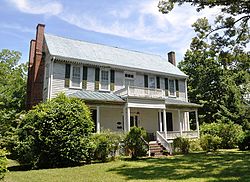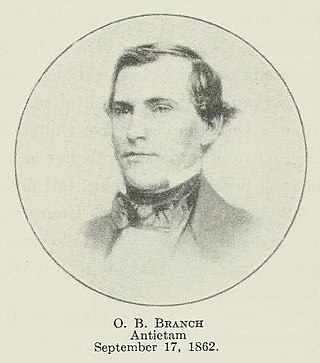
Lawrence O'Bryan Branch was a North Carolina representative in the U.S. Congress and a Confederate brigadier general in the American Civil War, killed at the Battle of Antietam. He owned 40 slaves.

The Meadows, also known as The Blake House, is a historic home located near Fletcher, Henderson County, North Carolina. It was built about 1860, and is a two-story, granite rubble stone dwelling in the Italianate style. It has a low hipped roof pierced with three interior chimneys and a two-story rear extension. The front facade features a one-bay porch flanked by semi-hexagonal bays.
Robert L. Doughton House is a historic home located at Laurel Springs, Alleghany County, North Carolina It was built in 1899, and is a two-story frame farmhouse in a vernacular Queen Anne style influenced frame cottage. It features a steeply pitched hip roof, with a two-story, one-bay gable roof projection. It was the home of Robert L. Doughton (1863-1954), one of North Carolina's foremost politicians of the first of the 20th century. In the 1990s Rufus A. Doughton's house was restored, and it is now a popular bed-and-breakfast for tourists to the region.
Jarvis House, also known as the Ira Jarvis House, is a historic home located near Sparta, Alleghany County, North Carolina. Located on the property are the contributing log building known as the log house, erected before 1850; the two-story 1880s Ira Jarvis House; and a detached stone cellar added in the early 1900s. The Ira Jarvis House is a simple tri-gable balloon-frame I-house with a hall and parlor plan.

Alleghany County Courthouse is a historic courthouse building located at Sparta, Alleghany County, North Carolina. It was built in 1933, and is a two-story, H-shaped Classical Revival style brick building. The front facade features a tetrastyle Tuscan order portico. It was built after "The Big Fire" of 1932 destroyed the courthouse and a block of businesses and homes.

Sloan–Throneburg Farm is a historic home and farm complex located near Chesterfield, Burke County, North Carolina. The main house was built about 1882, and is a two-story, three-bay, central hall plan frame I-house. Also on the property are the contributing landscape; Servant Dwelling, Ham House, and Wood Storage; Carriage House / Garage; Corncrib; Barn (1926); and Cave / Root Cellar.

Spurgeon House is a historic home near High Point, Davidson County, North Carolina. It was built about 1854 and is a two-story frame dwelling with Late Federal and Greek Revival design elements. It has an irregular configuration with a 1+1⁄2-story wing and two-story addition. Also on the property are contributing outbuildings including a kitchen, slave house, spring house, smokehouse, chickenhouse, two frame barns, a frame carriage house, and a log root cellar.

Cranford-Wannamaker House is a historic home located at Durham, Durham County, North Carolina. It was built in 1891 by local contractor T.S. Christian, and is a two-story, Shingle Style dwelling.

Person–McGhee Farm is a historic farm complex located at 5631 U.S. Highway 1 in Franklinton, Franklin County, North Carolina, about 4 miles north of town. The earliest section of the house was built sometime between 1770 and 1820, and is a three-bay, two-story frame dwelling over a stone-walled cellar. It has double shouldered brick end chimneys. In the 1890s, a large 2 1/2-story Queen Anne / Colonial Revival style section was added to the original Federal period dwelling. Also on the property are the contributing tenant house (1860s-1870s), a water tower, smokehouse, cattle barn, three log tobacco barns, and several sheds.
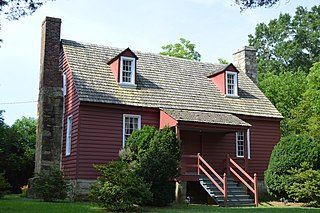
Person's Ordinary is a historic inn and tavern located at Littleton, Halifax County, North Carolina. It dates to the mid- to late-18th century, and is a 1 1/2-story frame dwelling, three bays wide and two deep, with a massive exterior stone chimney at each end. It rests on a stone cellar, and has a modified Quaker plan. The building housed an inn and tavern for stagecoach travelers into the 1830s and is associated with Thomas Person, one of the state's most important political leaders from 1760 to 1790.
Dr. Roscius P. and Mary Mitchell Thomas House and Outbuildings, also known as the Ruth Thomas Home Farm, is a historic home located near Bethlehem, Hertford County, North Carolina. The house was built in 1887, and is a two-story, three-bay, single-pile, side-gable roof, Late Victorian style frame dwelling with a two-story, gable-roof rear ell. Built into the ell is a Greek Revival style kitchen building. The house is sheathed in weatherboard, sits on a brick foundation, and has a one-story half-hip roof porch. Also on the property are the contributing doctor's office, smoke house, and root cellar.
The Gen. Joseph Arrington House is a historic plantation house located near Hilliardston, Nash County, North Carolina.
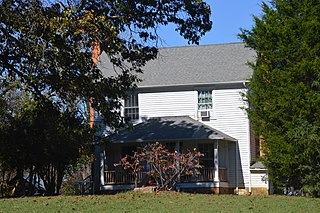
Holloway-Jones-Day House, also known as the Day House, is a historic home located near Roxboro, Person County, North Carolina. It was built about 1840, and is a two-story, Federal style frame farmhouse. A rear ell and hip roofed front porch with Italianate style decorative elements were added in the mid-19th century. It has brick gable end chimneys, front and rear transoms, a hall-parlor plan and a fieldstone cellar.
Fewell-Reynolds House is a historic home located near Madison, Rockingham County, North Carolina. It was built about 1820, and is a two-story, six-bay, central hall plan, Federal style frame dwelling with a one-story wing. It sits on a stone and brick foundation and has a steeply pitched gable roof. The front facade features a four-bay shed roofed porch.
Delta Farm, also known as the J.W. Scott Robinson Farm, is a historic home and farm located near Ivanhoe, Sampson County, North Carolina. The house was built in 1910, and is a two-story, five bay by four bay, double pile, Colonial Revival style frame dwelling. It has a hipped roof with front gable, brick pier foundation, and a front wrap-around porch. The interior features excellent woodwork. Also on the property are the contributing gas house, two-room servants-ironing house, two smokehouses, a storage house, root cellar, the remnants of the washhouse, and a former brick flower pit.
Livingston Oates Farm is a historic home and farm located near Clinton, Sampson County, North Carolina. The house was built about 1875, and is a one-story, double pile, Greek Revival style frame dwelling. It has a cross gable roof, rear ell, brick pier foundation, and a dominant front, pedimented, central porch. The interior is center-hall in plan. Also on the property are the contributing commissary, center aisle barn and stable, packhouse, an early gas pump, root cellar, tractor shed, and family cemetery.

The Hanckel-Barclay House, also known as Chestnut Hill, is a historic house in the Dunn's Rock community near Brevard, Transylvania County, North Carolina, bordered by the French Broad River and US Highway 276. The house was listed on the National Register of Historic Places in 1999.
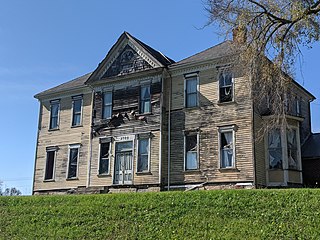
Josiah Crudup House is a historic home located near Kittrell, Vance County, North Carolina. It was built between 1833 and 1837, purchased by Josiah Crudup around 1835, and was originally a version of the tripartite Federal style composition and consisted of a two-story, three-bay, central section with one-story flanking wings. It was later enlarged and modified to its present form as a two-story central portion, topped by a steep pediment, and flanking two-story sections each with rather steep hip roofs. The house contained the first residential elevator in North Carolina.
The Bollinger-Hartley House is a historic house located at 423 North Main Street in Blowing Rock, Watauga County, North Carolina.
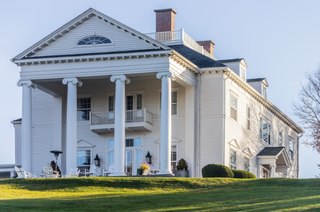
Westglow, also known as the Elliott Daingerfield House, is a historic home located near Blowing Rock, Watauga County, North Carolina. It was built in 1917, and is a 2+1⁄2-story, rectangular, Colonial Revival style frame dwelling with a hipped roof. It has a two-story hip roof extension. The front facade features a monumental tetrastyle portico supported by columns with Ionic order capitals. Also on the property are the contributing artists studio and caretaker's cottage (1920s). It was the summer home and studio of artist Elliot Daingerfield (1859-1932).
